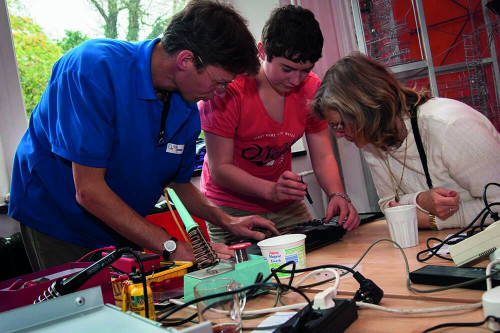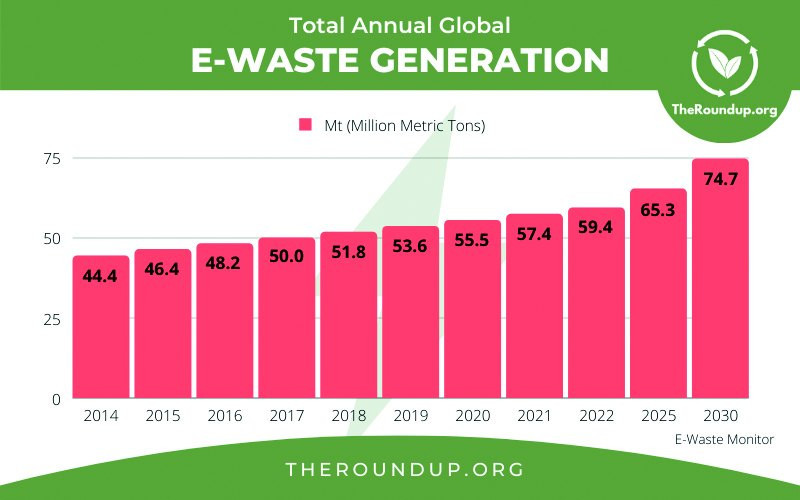During and after the World War and in the former GDR, people thought and acted similarly to the elderly lady in the Bois Francs, who once said that she still collects every button and every thread, because in her youth the family lived on $5 over the winter and couldn't leave the house because the snow was too high and there was no electricity or telephone. Today, every seasoned teenager has at least four or five old cell phones in her various drawers. After all, she can't show off an old model among her peers.
 Breaking the seal: Volunteer repair work at Stichting Repair Café InternationalMaking electronicsalready produces enough toxins and waste without having to look at the end product. But it seems strange at first glance that most products are designed in such a way that they cannot be repaired. Even the battery, which only remains functional for a short time, cannot be replaced by the average person.
Breaking the seal: Volunteer repair work at Stichting Repair Café InternationalMaking electronicsalready produces enough toxins and waste without having to look at the end product. But it seems strange at first glance that most products are designed in such a way that they cannot be repaired. Even the battery, which only remains functional for a short time, cannot be replaced by the average person.
But then you realize that this 'planned obsolescence' [2] has been practiced for a long time to increase or maintain sales, be it for silk stockings, cars or coffee machines. A weak point is systematically created somewhere, forcing the user to rush back to the store and buy a 'new' product that won't last any longer.
The effect is then found in the dustbin - or in some European countries now at the scrap dealer or a collection point, should the citizen follow the guidelines.
The masses (53.6 million tons were generated in 2019 and the forecast for 2030 is around 74.7 million tons [3]) should conceal many treasures, such as rare earths or precious metals, which would otherwise have to be laboriously scraped out of the ground.
The vast majority of electronic waste still ends up in landfill sites, leading to toxic and bioaccumulative environmental damage. These include polychlorinated biphenyls, polybrominated biphenyls and heavy metals, which does not exhaust the list of possible chemicals.
Instead of digging in the ground, it might make sense to recover economically important materials from scrap. Expensively mined base metals such as zinc, lead, copper and nickel are already present in fairly pure form. Metals such as selenium and indium are rarer, but are also found in components. Although China now has a stranglehold on rare earths such as yttrium and lanthanum, apart from the military, we also find them in electronic scrap, and already refined. Anyone who has ever wondered about the gold plating of connectors knows that precious metals such as gold and silver could also be recovered in considerable quantities.
Environmentalists and quite clever technicians have calculated that recovering such materials from scrap would be far cheaper than mining them originally, because, for example, cell phones (without batteries) contain far more gold, nickel, lead and copper per unit weight than natural ores.
 Instead of digging in the ground, it would perhaps make sense to recover certain materials from the scrap.Old components are also carefully salvaged and then offered to the customer as 'new', but except in some low-wage countries, where men and women and a horde of children sit on the ground earning a meagre wage and probably poisoning themselves, attempts are being made to recover critical materials using mass processes, which are commercially more attractive in Western countries.
Instead of digging in the ground, it would perhaps make sense to recover certain materials from the scrap.Old components are also carefully salvaged and then offered to the customer as 'new', but except in some low-wage countries, where men and women and a horde of children sit on the ground earning a meagre wage and probably poisoning themselves, attempts are being made to recover critical materials using mass processes, which are commercially more attractive in Western countries.
Among the possible methods for recovering metals from scrap (pyrometallurgical, hydrometallurgical, physical and combined techniques), pyrometallurgical processes [4] are currently preferred on a commercial scale. Due to the expense and possible hazardous substances, attempts are constantly being made to develop more elegant methods to improve both the pre-treatment and the efficiency of extraction processes.
The enormous amounts of energy and hazardous substances generated are one reason, the profit is another.
The fact that something like this could be 'interesting' can be seen from figures such as these: in 2016 alone, $55 billion worth of gold, silver, copper and other high-quality recoverable materials were not recovered from scrap metal.
According to the Federal Environment Agency, around 853,124 tons of old electrical appliances were collected in Germany in 2018. The trend is of course rising and, as usual, politicians react late and then after the child has fallen into the well. Supply and demand can be addressed at two points. By promoting disposal instead of regulating supply and improving usage times and repair options [5], the law ensures that more and more scrap is generated, as the manufacturer no longer needs to have a guilty conscience. What has been far less well received in the press than Greta Thunberg's vague announcements are the efforts of some adults who propagate: 'Repairing instead of throwing away is not fashionable! Which brings us back to the post-war period and the former GDR.
But whether the group with the action artist HA Schult [6] and his Wertgiganten will be able to make its presence felt and achieve anything is written in the stars. In any case, the demands are more clearly formulated than those of the high school students, which is probably why neither journalists nor politicians like to question him.
 The forecasts up to 2030 are not exactly optimistic
The forecasts up to 2030 are not exactly optimistic
Ultimately, the culprits in this misery are the manufacturers and distributors, who are looking at their billions in profits, the buyers (including the Fridays for Future activists, if the published photos with the many cell phones are to be believed), who are caught up in the advertising, the parents, who push baby carriages in front of them with a cell phone to their ear and thus teach babies what is 'important' and ultimately probably also many politicians, who would rather invest in the military than in the education of young people.
References
[1] German proverb
[2] https://en.wikipedia.org/wiki/
Planned_obsolescence
[3] Reginald Davey, An Overview of Printed Circuit Board Recycling and Resource Recovery. Nov 22, 2021
[4] Pyrometallurgy - processes of metal extraction and metal refining that require high temperatures (200-3000 °C) and take place in the absence of oxygen.
[5] https://www.presseportal.de/pm/127001/5101155
[6] https://en.wikipedia.org/wiki/HA_Schult
Literature
Stichting Repair Café International, www.repaircafe.org
Taiwo K. Aladeojebi: Planned Obsolescence, International Journal of Scientific & Engineering Research, Volume 4, Issue 6, June-2013
R. Cooper: Ethics and Altruism: What Constitutes Socially Responsible Design?, Design Management Review 16, 2005
V. Packard: The Waste Makers, New York, NY, David McKay, 1960

![Because the spoon is new, the cook needs it; when it gets old, he throws it away [1]](/images/k2/85fab6ece2f857139abac6536d36e1d3.jpg)
